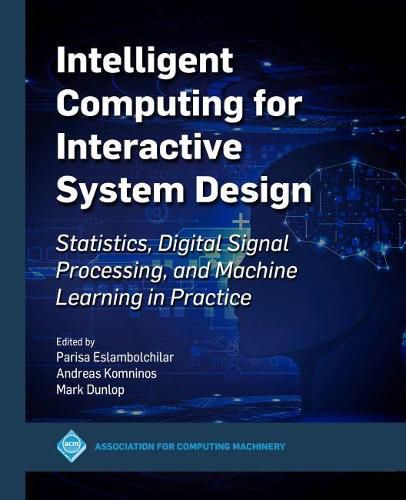Readings Newsletter
Become a Readings Member to make your shopping experience even easier.
Sign in or sign up for free!
You’re not far away from qualifying for FREE standard shipping within Australia
You’ve qualified for FREE standard shipping within Australia
The cart is loading…






This title is printed to order. This book may have been self-published. If so, we cannot guarantee the quality of the content. In the main most books will have gone through the editing process however some may not. We therefore suggest that you be aware of this before ordering this book. If in doubt check either the author or publisher’s details as we are unable to accept any returns unless they are faulty. Please contact us if you have any questions.
Intelligent Computing for Interactive System Design provides a comprehensive resource on what has become the dominant paradigm in designing novel interaction methods, involving gestures, speech, text, touch and brain-controlled interaction, embedded in innovative and emerging human-computer interfaces. These interfaces support ubiquitous interaction with applications and services running on smartphones, wearables, in-vehicle systems, virtual and augmented reality, robotic systems, the Internet of Things (IoT), and many other domains that are now highly competitive, both in commercial and in research contexts.
This book presents the crucial theoretical foundations needed by any student, researcher, or practitioner working on novel interface design, with chapters on statistical methods, digital signal processing (DSP), and machine learning (ML). These foundations are followed by chapters that discuss case studies on smart cities, brain-computer interfaces, probabilistic mobile text entry, secure gestures, personal context from mobile phones, adaptive touch interfaces, and automotive user interfaces. The case studies chapters also highlight an in-depth look at the practical application of DSP and ML methods used for processing of touch, gesture, biometric, or embedded sensor inputs. A common theme throughout the case studies is ubiquitous support for humans in their daily professional or personal activities.
In addition, the book provides walk-through examples of different DSP and ML techniques and their use in interactive systems. Common terms are defined, and information on practical resources is provided (e.g., software tools, data resources) for hands-on project work to develop and evaluate multimodal and multi-sensor systems. In a series of in-chapter commentary boxes, an expert on the legal and ethical issues explores the emergent deep concerns of the professional community, on how DSP and ML should be adopted and used in socially appropriate ways, to most effectively advance human performance during ubiquitous interaction with omnipresent computers.
This carefully edited collection is written by international experts and pioneers in the fields of DSP and ML. It provides a textbook for students and a reference and technology roadmap for developers and professionals working on interaction design on emerging platforms.
$9.00 standard shipping within Australia
FREE standard shipping within Australia for orders over $100.00
Express & International shipping calculated at checkout
This title is printed to order. This book may have been self-published. If so, we cannot guarantee the quality of the content. In the main most books will have gone through the editing process however some may not. We therefore suggest that you be aware of this before ordering this book. If in doubt check either the author or publisher’s details as we are unable to accept any returns unless they are faulty. Please contact us if you have any questions.
Intelligent Computing for Interactive System Design provides a comprehensive resource on what has become the dominant paradigm in designing novel interaction methods, involving gestures, speech, text, touch and brain-controlled interaction, embedded in innovative and emerging human-computer interfaces. These interfaces support ubiquitous interaction with applications and services running on smartphones, wearables, in-vehicle systems, virtual and augmented reality, robotic systems, the Internet of Things (IoT), and many other domains that are now highly competitive, both in commercial and in research contexts.
This book presents the crucial theoretical foundations needed by any student, researcher, or practitioner working on novel interface design, with chapters on statistical methods, digital signal processing (DSP), and machine learning (ML). These foundations are followed by chapters that discuss case studies on smart cities, brain-computer interfaces, probabilistic mobile text entry, secure gestures, personal context from mobile phones, adaptive touch interfaces, and automotive user interfaces. The case studies chapters also highlight an in-depth look at the practical application of DSP and ML methods used for processing of touch, gesture, biometric, or embedded sensor inputs. A common theme throughout the case studies is ubiquitous support for humans in their daily professional or personal activities.
In addition, the book provides walk-through examples of different DSP and ML techniques and their use in interactive systems. Common terms are defined, and information on practical resources is provided (e.g., software tools, data resources) for hands-on project work to develop and evaluate multimodal and multi-sensor systems. In a series of in-chapter commentary boxes, an expert on the legal and ethical issues explores the emergent deep concerns of the professional community, on how DSP and ML should be adopted and used in socially appropriate ways, to most effectively advance human performance during ubiquitous interaction with omnipresent computers.
This carefully edited collection is written by international experts and pioneers in the fields of DSP and ML. It provides a textbook for students and a reference and technology roadmap for developers and professionals working on interaction design on emerging platforms.